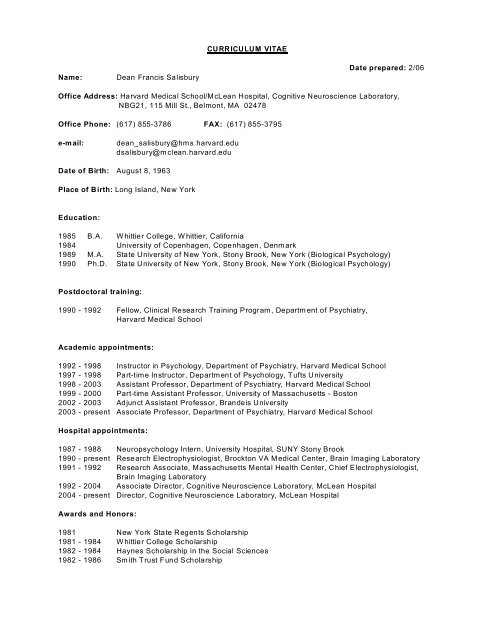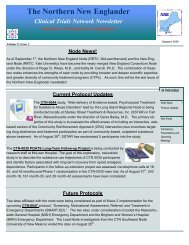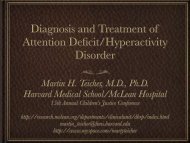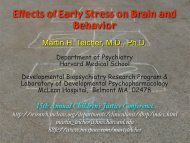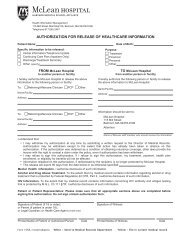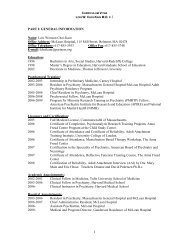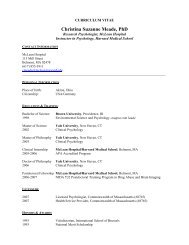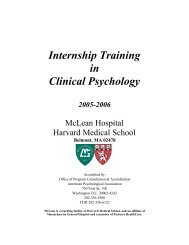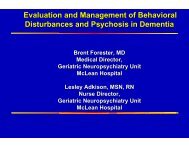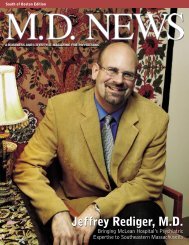CURRICULUM VITAE Date prepared: 2/06 Name - McLean Hospital ...
CURRICULUM VITAE Date prepared: 2/06 Name - McLean Hospital ...
CURRICULUM VITAE Date prepared: 2/06 Name - McLean Hospital ...
Create successful ePaper yourself
Turn your PDF publications into a flip-book with our unique Google optimized e-Paper software.
<strong>Name</strong>: Dean Francis Salisbury<br />
<strong>CURRICULUM</strong> <strong>VITAE</strong><br />
<strong>Date</strong> <strong>prepared</strong>: 2/<strong>06</strong><br />
Office Address: Harvard Medical School/<strong>McLean</strong> <strong>Hospital</strong>, Cognitive Neuroscience Laboratory,<br />
NBG21, 115 Mill St., Belmont, MA 02478<br />
Office Phone: (617) 855-3786 FAX: (617) 855-3795<br />
e-mail: dean_salisbury@hms.harvard.edu<br />
dsalisbury@mclean.harvard.edu<br />
<strong>Date</strong> of Birth: August 8, 1963<br />
Place of Birth: Long Island, New York<br />
Education:<br />
1985 B.A. W hittier College, W hittier, California<br />
1984 University of Copenhagen, Copenhagen, Denmark<br />
1989 M.A. State University of New York, Stony Brook, New York (Biological Psychology)<br />
1990 Ph.D. State University of New York, Stony Brook, New York (Biological Psychology)<br />
Postdoctoral training:<br />
1990 - 1992 Fellow, Clinical Research Training Program, Departm ent of Psychiatry,<br />
Harvard Medical School<br />
Academic appointments:<br />
1992 - 1998 Instructor in Psychology, Department of Psychiatry, Harvard Medical School<br />
1997 - 1998 Part-time Instructor, Department of Psychology, Tufts University<br />
1998 - 2003 Assistant Professor, Department of Psychiatry, Harvard Medical School<br />
1999 - 2000 Part-time Assistant Professor, University of Massachusetts - Boston<br />
2002 - 2003 Adjunct Assistant Professor, Brandeis University<br />
2003 - present Associate Professor, Department of Psychiatry, Harvard Medical School<br />
<strong>Hospital</strong> appointments:<br />
1987 - 1988 Neuropsychology Intern, University <strong>Hospital</strong>, SUNY Stony Brook<br />
1990 - present Research Electrophysiologist, Brockton VA Medical Center, Brain Imaging Laboratory<br />
1991 - 1992 Research Associate, Massachusetts Mental Health Center, Chief Electrophysiologist,<br />
Brain Imaging Laboratory<br />
1992 - 2004 Associate Director, Cognitive Neuroscience Laboratory, <strong>McLean</strong> <strong>Hospital</strong><br />
2004 - present Director, Cognitive Neuroscience Laboratory, <strong>McLean</strong> <strong>Hospital</strong><br />
Awards and Honors:<br />
1981 New York State Regents Scholarship<br />
1981 - 1984 W hittier College Scholarship<br />
1982 - 1984 Haynes Scholarship in the Social Sciences<br />
1982 - 1986 Sm ith Trust Fund Scholarship
Awards and Honors: (continued)<br />
1985 - 1990 Graduate Assistantship, SUNY Stony Brook<br />
1990 Sigma Xi Grant-in-aid of Research<br />
1992 Sleep Research Society Travel Award<br />
1993 National Institute of Mental Health Young Investigator Award<br />
1993 - 1995 McDonnell-Pew Program in Cognitive Neuroscience Award<br />
1995 - 1997 National Alliance for Research in Schizophrenia and Depression Young Investigator Award<br />
1997 - 1999 National Alliance for Research in Schizophrenia and Depression Young Investigator Award<br />
2001 - 2005 National Institutes of Mental Health RO1 Award<br />
Major Committee Assignments:<br />
1988 - 1989 Grievance committee, Department of Psychology, SUNY Stony Brook<br />
1989 - 1990 Advisory committee, Department of Psychology, SUNY Stony Brook<br />
2000 - present NIMH Behavioral Science Track Award for Rapid Transition (B/START), Ad Hoc Reviewer<br />
2001 - 20<strong>06</strong> Human Resources Policy Review and Advisory Committee, <strong>McLean</strong> <strong>Hospital</strong><br />
2002 Member, National Institute of Mental Health Workshop Planning Meeting: First Episode<br />
Schizophrenia<br />
2002 - 2004 Convention Site Committee, Society for Psychophysiological Research<br />
2003 NIMH Center for Scientific Review, Psychophysiological Responses and Cognition, Special<br />
Emphasis Panel<br />
2003 - present Harvard Medical School, Department of Psychiatry, Mysell Award Committee<br />
2003 NIMH Center for Scientific Review, Clinical Neuroplasticity and Neurotransmitters, Special<br />
Emphasis Panel<br />
2003 - present Harvard Medical School, Department of Psychiatry, Research Committee<br />
2004 NIMH Center for Scientific Review, Medical Devices SBIR, Special Emphasis Panel<br />
2004 - present NIMH Center for Scientific Review, Clinical Neurophysiology, Devices, and Neuroprosthetics<br />
Study Section, ZRG1 BDCN-K 10<br />
2005 Chair, NIMH Center for Scientific Review, Bioengineering Research Partnerships Study<br />
Section, BDCN - BRP K-50R<br />
2005 - present Membership Committee, Society for Psychophysiological Research<br />
20<strong>06</strong> - Chair, Harvard Medical School, Department of Psychiatry, Mysell Award Committee<br />
Professional Society Involvement:<br />
1990 - present Society for Psychophysiological Research, Member<br />
1993 - 2003 American Psychological Society, Member<br />
2002 - 2004 Convention Site Committee, Society for Psychophysiological Research<br />
2003 - present Society for Biological Psychiatry, Member<br />
2003 - present Cognitive Neuroscience Society, Member<br />
2005 - present Membership Committee, Society for Psychophysiological Research<br />
2005 - present Board Member, Electroencephalography and Clinical Neuroscience Society<br />
Editorial Boards:<br />
Consulting Editor:<br />
1991 - present Sleep<br />
1994 - present Archives of General Psychiatry<br />
1996 - present Psychophysiology<br />
1997 - present Biological Psychiatry<br />
1998 - present Schizophrenia Bulletin<br />
1998 - present Psychiatry Research<br />
1998 - present Schizophrenia Research<br />
1999 - present Psychological Medicine<br />
2001 - present Cognitive Brain Research<br />
2001 - present Psychological Bulletin<br />
2002 - present American Journal of Psychiatry<br />
2002 - present Journal of Abnormal Psychology<br />
2
2002 - present Biological Psychology<br />
2002 - present Journal of Psychiatry & Neuroscience<br />
2002 - present Neurophysiologie Clinique<br />
2003 - present Clinical Neurophysiology<br />
2003 - present Journal of Cognitive Neuroscience<br />
2004 - present Brain and Language<br />
20<strong>06</strong> - present Progress in Neuro-Psychopharmacology & Biological Psychiatry<br />
Associate Editor<br />
20<strong>06</strong> - Psychophysiology<br />
20<strong>06</strong> - Psychiatry Research<br />
Report of Research:<br />
Major Research Interests:<br />
1) Human cognitive electrophysiology with special interest in language processing and meaning activation,<br />
and the relationship between cortical structural organization and the electrophysiology of higher-order<br />
cognitive operations.<br />
2) Electrophysiological signs of language and cognitive dysfunction in schizophrenia and psychotic bipolar<br />
disorder.<br />
3) Response mode factors that affect the electrical topography of event-related potentials.<br />
4) Brain electrical activity reflecting stimulus processing during sleep.<br />
Narrative Report of Research:<br />
My research utilizes electrophysiology and multimodal brain imaging. I specialize in event-related<br />
potential macropotential recordings in humans and have collaborated over the last decade with researchers<br />
using MR and fMR imaging methods. Models of normal brain function need to be constrained by an<br />
awareness of differences that arise when the brain is compromised. To that end, I have examined thought<br />
disturbance (cognitive-level) and basic auditory processing abnormalities (sensory-level) in psychosis and well<br />
controls.<br />
Thought disorder is a cardinal symptom of schizophrenia, and is inferred through abnormal language.<br />
Disordered thought has a high genetic penetrance, and is detected in relatives of schizophrenia patients at<br />
a high rate, even when these relatives do not exhibit overt psychosis. Thus, examination of thinking problems<br />
may be especially insightful for understanding schizophrenia. The broad aim of my work is to combine<br />
behavioral measures and brain activity measure to further understand the underlying interplay between<br />
semantic memory neural networks subserving concept storage and verbal working memory systems that allow<br />
adaptive and flexible human behavior in the face of unique current situations. More specifically, the aims are<br />
to understand automatic semantic activation versus controlled verbal working memory inhibition and to relate<br />
these dysfunctions to underlying brain systems, so as to understand the neurophysiology of psychosis.<br />
Autom atic mem ory processes and related brain activity during language processing tasks using lexical<br />
ambiguities (homographs like toast, box, or panel) are contrasted with controlled contextual inhibitory<br />
processes and related brain activity. In addition to homograph processing and expectancy-based priming, we<br />
measure high frequency brain activity (gamma waves) to lexical access to examine semantic memory neural<br />
network structure across the brain. Memories are stored in distributed networks, and gamma activity allows<br />
the distributed brain areas to work in concert. We also examine the effects of recent memory traces and<br />
recent response outcome traces on current behavior, to assess how memory traces benefit or detract from<br />
current performance, especially in patients. The studies will help determine where in the information<br />
processing stream most blame can be laid for thought disorder, early in the automatic semantic memory<br />
system or later in the controlled working memory system. These results, in turn, when related to underlying<br />
brain system s will help to clarify the nature of thought disorder and cognitive dysfunction in schizophrenia with<br />
respect to actual brain structure and function.<br />
Another program of research looks at basic auditory sensory processing in first-episode psychotic<br />
patients and chronically-ill psychotic patients to determine where abnormalities occur in patients in basic<br />
auditory processing relative to controls, and where patients with schizophrenia differ from patients with m ania<br />
and affective psychosis. In addition, MR measures allow us to determine whether the neural substrates of<br />
these brain processes are also affected in the diseases, and to determine whether we can find brain-behavior<br />
relationships between the size of the electrical brain responses we record and the structural measures derived<br />
3
from MR. We also can determine the degree to which such brain-behavior relationships are present at first<br />
psychotic episode and how they develop over time with disease duration through our cross-sectional<br />
measures of first-episode patients and chronic patients, and through longitudinal assessments of first episode<br />
patients. Our data to date suggest that patients first hospitalized with schizophrenia show an abnormality that<br />
is lateralized to the auditory processing centers of the left tem poral lobe in the P300 event-related brain<br />
potential, a brainwave associated with goal-directed stim ulus detection. This P300 voltage abnormality is<br />
correlated with the size of abnormal cortical gray matter reductions in the left posterior superior temporal<br />
gyrus, a polymodal, complex tertiary area of temporal-parietal association cortex. Interestingly, patients first<br />
hospitalized with psychotic mania do not show this pattern of brain structural-functional abnormalities.<br />
Furthermore, patients with first-episode schizophrenia do not show abnormalities in an earlier brain potential<br />
termed mismatch negativity that reflects the early sensory memory automatic detection of stimulus deviance.<br />
However, the size of the mism atch negativity voltage is correlated with the size of Heschl’s gyrus gray matter,<br />
which contains primary auditory cortex in patients at first schizophrenic episode, suggesting that mismatch<br />
negativity may be sensitive to the presence of an initial mild reduction of auditory cortical neuropil. Most<br />
importantly, our longitudinal data shows that mismatch negativity, which is in the normal range at first<br />
hospitalization, becomes progressively abnormal in patients along with the duration of their disease. This<br />
suggests that mismatch negativity may serve as a index of progressive disease pathological processes in the<br />
first few years of schizophrenia.<br />
Research Funding Information:<br />
Principal Investigator<br />
1990 Sigma Xi Grant in Aid of Research. An electrophysiological investigation of auditory eventrelated<br />
potentials and the K complex generated during sleep in humans.<br />
1993 - 1995 McDonnell-Pew Cognitive Neuroscience Program. Electrophysiological indices of<br />
language processing and ambiguity.<br />
1995 - 1997 NARSAD Young Investigator Award. Brain activity measures of language processing and<br />
am biguity.<br />
1997 - 1999 NARSAD Young Investigator Award. Brain activity, ambiguity, and semantic activation<br />
in psychosis.<br />
2001 - 2005 National Institutes of Mental Health, RO1 MH58704. Brain activity and language<br />
comprehension in psychosis.<br />
Mentor<br />
2005 Clinical Research Training Program Post-Doctoral Fellowship. PI: Spencer Lynn, PhD.<br />
Co-Investigator<br />
1990 - present National Institutes of Mental Health, RO1 MH40799, PI Robert W. McCarley.<br />
Neurophysiological Studies of Schizophrenia.<br />
1992 - 1996 National Institutes of Mental Health, P01 MH 31154, PI Phillip Holzman, Collaborative<br />
Biological Research in Schizophrenia. Project PI Robert W. McCarley. Electrophysiology<br />
Studies in Schizophrenia.<br />
1992 - present Veterans Administration Merit Review Award. PI Robert W . McCarley. Neurophysiology of<br />
Behavior.<br />
1994 - present National Institutes of Mental Health, RO1 MH 50740, PI Martha E. Shenton. Computerized<br />
Image Analyses of MR Scans in Schizophrenia.<br />
1994 - present National Institutes of Mental Health, RO1 MH 52807, PI Robert W . McCarley. Biological<br />
Basis of Schizotypal Personality Disorder.<br />
1995 - 2000 Veterans Administration Center for Basic and Clinical Neuroscience Studies of<br />
Schizophrenia. PI Robert W. McCarley. The Neuroscience of Schizophrenia.<br />
2001 - 2005 Veterans Administration Merit Review Award. C0-PIs Paul G. Nestor, Margaret Niznikiewicz.<br />
Psychobiology of schizophrenia.<br />
Pending<br />
20<strong>06</strong> - 2011 National Institutes of Mental Health, RO1 MH58704. Brain activity and language<br />
com prehension in psychosis. Competitive renewal. Priority Score: 126, percentile: 3.3<br />
4
Report of Teaching:<br />
Local Contributions:<br />
Teaching Assistantships<br />
1985 Brain and Behavior, SUNY Stony Brook<br />
100 Undergraduate students, 5 hours/week, 15 weeks<br />
1986 Human Brain Function, SUNY Stony Brook<br />
30 Undergraduate students, 5 hours/week, 15 weeks<br />
1986 Electrophysiology Lab, SUNY Stony Brook<br />
15 Undergraduate students, 5 hours/week, 15 weeks<br />
1987 Sensation and Perception, SUNY Stony Brook<br />
30 Undergraduate students, 5 hours/week, 15 weeks<br />
1987 Brain and Behavior, SUNY Stony Brook<br />
100 Undergraduate students, 5 hours/week, 15 weeks<br />
1988 Advanced Physiological Psychology, SUNY Stony Brook<br />
30 Undergraduate students, 5 hours/week, 15 weeks<br />
1988 Abnormal Psychology, SUNY Stony Brook<br />
100 Undergraduate students, 5 hours/week, 15 weeks<br />
1989 Statistics, SUNY Stony Brook<br />
40 Undergraduate students, 5 hours/week, 15 weeks<br />
Instructor<br />
1989 Abnormal Psychology, SUNY Stony Brook<br />
61 Undergraduate students, 15 hours/week, 5 weeks<br />
1989 Sensation and Perception, SUNY Stony Brook<br />
53 Undergraduate students, 15 hours/week, 5 weeks<br />
1989 Sensation and Perception, SUNY Stony Brook<br />
89 students, 5 hours/week, 15 weeks<br />
1990 Human Brain Function, SUNY Stony Brook<br />
47 Undergraduate students, 5 hours/week, 15 weeks<br />
1997 Cognitive Neuroscience and Psychopathology, Tufts University<br />
3 Graduate, 2 Senior Undergraduate students, 5 hours/week, 15 weeks<br />
1997 Cognitive Neuropsychology, Tufts University,<br />
2 Graduate, 4 Undergraduate students, 5 hours/wk, 15 weeks<br />
1998 Developmental Psychology, Tufts University<br />
24 Undergraduate students, 5 hours/wk, 15 weeks<br />
1998 Cognitive Psychology, Tufts University<br />
12 Undergraduate students, 15 hours/wk, 5 weeks<br />
1999 Cognitive Psychology, University of Massachusetts - Boston<br />
17 Undergraduate students, 5 hours/wk, 15 weeks<br />
5
1999 Sensation and Perception, University of Massachusetts - Boston<br />
17 Undergraduate students, 5 hours/wk, 15 weeks<br />
2002 Introduction to Cognitive Neuroscience, Brandeis University, Waltham , MA<br />
41 Undergraduate students, 5 hours/wk, 15 weeks<br />
Independent Student Research Supervision<br />
1991 - present Undergraduate Student Advisor<br />
Full-time research assistants, Undergraduate research assistants, and Stanley Foundation<br />
Summer Fellows: Edward DiMartino, Melissa Freidman, Amy Benavage, Lisa Kaplan, Wendy<br />
Chang, Lola Lee, Evana Goodreau, Stephanie Rose, Andrea Sherwood, Iris Fischer, Em ily<br />
Chase, Paola Mazzoni, Michele Harper, Bret Rutherford, Sara DeLong, Massimo DeSantis,<br />
Ana Garnecho, Jon-Paul Pepper, Deirdre Farrell, Carlye Griggs, Aaron Bonner-Jackson,<br />
Seema Aurora, Andrea Okruch, Lynn Stravinski, Meg Fagan, Nicola Sumorok, Lori Schwatrz,<br />
Rachel Berman, Akanksha Thakur, Courtney Brown, KC Collins, Mukund Sureshbabu, Marcy<br />
Adler, Matthew Chao<br />
1995 - 1997 Resident Research Advisor<br />
1 Medical Doctor<br />
Alexandra Berezovskaya, MD<br />
1997 - 1999 Graduate Student Advisor (Psychology)<br />
2 Graduate students, Tufts University<br />
Students: Juliana Pare-Blagoev, Tatiana Sitnikova<br />
1997 - 1998 Preparation for the Honors Thesis, Harvard University<br />
1 Undergraduate student<br />
5 hours/wk, 30 weeks<br />
2001 High School Student Advisor<br />
1 student, 20 hours/wk, 10 weeks<br />
2002 Internship and Analysis, Brandeis University, Waltham , MA<br />
1 Undergraduate Student<br />
6 hours/wk, 15 weeks<br />
Post-Doctoral Fellow Mentor<br />
2005 - present Spencer K. Lynn, Clinical Research Training Program T32, Affective Neuroscience<br />
Regional, National, and International Contributions:<br />
Invited Presentations:<br />
1990 Auditory event-related potentials evoked during human sleep. Clinical Research Training Program,<br />
Harvard Medical School/Mass. Mental Health Center<br />
1991 Event-related potential measures of attention: The Nd response and the P3 complex. Cognitive<br />
Neuroscience Colloquium, Brockton VAMC<br />
1991 Stimulus configuration effects on the ERPs in schizophrenics and controls: An analysis using signal<br />
detection theory. Clinical Research Training Program, Harvard Medical School<br />
1992 P3 and Stimulus Parameters. Clinical Research Training Program, Harvard Medical School<br />
1993 Stimulus processing awake and asleep: Similarities and differences in electrical CNS responses.<br />
Sleep Onset Mechanisms. Ontario, Canada<br />
6
1993 Functional aspects of P3 in schizophrenia. American Meeting on Cognitive ERP Research,<br />
Columbia University, New York<br />
1994 Does P3 topography discriminate schizophrenic psychosis from affective psychosis? Society<br />
for Neuroscience Annual Meeting, Miami Beach, Florida<br />
1995 Asymmetrical P3 topography in first episode schizophrenia-like psychosis. International<br />
Congress of Schizophrenia Research, W arm Springs, Virginia<br />
1995 Thought disorder in schizophrenia: Lack of controlled inhibition of semantic activation.<br />
Biopsychology Proseminar, Department of Psychology, SUNY Stony Brook<br />
1995 P3 topography differs in schizophrenia-like and mania-like first episode psychosis. Biological<br />
Psychiatry Annual Meeting, Miami Beach, Florida<br />
1995 Examining thought disorder in schizophrenia with homographs: Evidence from event-related<br />
potentials. Department of Psychology, W hittier College, W hittier, California<br />
1997 P300 asymmetry in chronic and first episode schizophrenia. Special Joint Conference, Department<br />
of Psychiatry, University of the Ryukyus. Okinawa, Japan<br />
1997 Temporal P300 asymmetry in first episode schizophrenia versus manic psychosis and controls.<br />
International Congress on Schizophrenia Research, Colorado Springs, Colorado<br />
1997 Abnormal ERP activity despite normal performance to homographs in schizophrenia. Biological<br />
Psychiatry, San Diego, California<br />
1997 Left temporal P3 reductions in chronic and first episode schizophrenia. Biological Psychiatry, San<br />
Diego, California<br />
1999 Longitudinal study of P300 topography in first episode psychosis. International Congress on<br />
Schizophrenia Research, Sante Fe, New Mexico<br />
1999 Left posterior superior temporal gyrus: Progressive gray matter volume reduction in schizophrenia.<br />
International Congress on Schizophrenia Research, Sante Fe, New Mexico<br />
1999 Conjoint structural MRI and ERP studies in schizophrenia: Evidence for a “hot spot” of dominant<br />
hemisphere abnormalities that is present at onset and also progresses. Psychophysiology, Grenada,<br />
Spain<br />
2000 A cognitive neuroscience view of schizophrenia: Basic and complex structural and functional<br />
abnormalities. Neuroscience Seminar, <strong>McLean</strong> <strong>Hospital</strong>, Belmont, MA.<br />
2000 Using event-related potentials to study cognitive processing: A look inside the “black box”.<br />
Department of Psychology, Gettysburg College, Gettysburg, PA.<br />
2000 Using event-related potentials to study cognitive processing: A look inside the “black box”.<br />
Department of Psychology, Colgate University, Hamilton, NY.<br />
2001 Mismatch negativity in schizophrenia: Does MMN amplitude decline with disease duration? Biological<br />
Psychiatry, New Orleans, LA.<br />
2001 Thought disorder in psychosis: Using language-related ERPs to probe cognitive dysfunction in<br />
schizophrenia. SUNY Stony Brook, Department of Psychology, Stony Brook, NY.<br />
2001 Brain function and structure in schizophrenia: Relationship between cortex, mismatch negativity and<br />
P300. Nathan Kline Institute, Orangeburg, NY.<br />
7
2001 Cognitive Neuroscience models of verbal memory in schizophrenia. Psychophysiology, Montreal,<br />
Canada.<br />
2002 Homograph network strength, associative strength, incongruity, and N400. Psychophysiology,<br />
Washington, DC.<br />
2003 Electrophysiology and MRI of automatic and controlled attention mechanisms in first-episode and<br />
chronic schizophrenia. Department of Psychology, Vanderbilt University, Nashville, TN.<br />
2003 Autom atic and controlled attention processes in schizophrenia: Functional and structural indices of<br />
progressive cortical degeneration following first hospitalization. Yale University School of Medicine,<br />
Departm ent of Psychiatry, W est Haven, CT.<br />
2003 Mismatch negativity amplitude and Heschl’s gyrus volume in first-episode schizophrenia. International<br />
Congress of Schizophrenia Research, Colorado Springs, CO.<br />
2003 A Cognitive Neuroscience Approach to Thinking Disturbance in Schizophrenia: From Auditory<br />
Sensory Mem ory to Distributed Verbal Mem ory. Department of Psychology, Kansas University.<br />
2003 Basic electrophysiology and theory of m ism atch negativity. EEG and Clinical Neuroscience Society,<br />
Houston, TX.<br />
2003 Dominant and subordinate homograph meaning selection in schizophrenia. Department of<br />
Psychology, Rice University, Houston, TX.<br />
2003 Verbal working memory and semantic memory in schizophrenia: A model of fronto-temporal<br />
interactions. Psychophysiology, Chicago, IL.<br />
2003 ERP and MRI investigations of echoic memory in schizophrenia via the mismatch paradigm.<br />
Psychophysiology, Chicago, IL.<br />
2003 Basic MRI and EEG correlates of selective attention in chronic and first episode schizophrenia.<br />
Department of Psychology, Whittier College, Whittier, CA.<br />
2003 ERP and MRI investigations of low-level attention in schizophrenia: Evidence of peri-onset<br />
progressive structural and functional impairment. Schizophrenia and Bipolar Disorders Lecture Series,<br />
<strong>McLean</strong> <strong>Hospital</strong>, Belmont, MA.<br />
2004 Mismatch negativity as a probe of early cortical processing in schizophrenia: Electrophysiological and<br />
structural MRI indices of progressive cortical reduction near disease onset. Schizophrenia Program<br />
Invited Lecture Series, Massachusetts General <strong>Hospital</strong>, Boston, MA.<br />
2004 P300 ERP and MRI asymmetry in first episode schizophrenia. International Congress of Biological<br />
Psychiatry, Sydney, Australia.<br />
2004 Mismatch negativity: A possible ERP and fMRI index of post-onset progression of brain changes in<br />
schizophrenia. International Congress of Biological Psychiatry, Sydney, Australia.<br />
2004 ERP and structural MR correlates of automatic and controlled attention in schizophrenia. International<br />
Congress of Biological Psychiatry, Sydney, Australia.<br />
2004 Event-related potential and homograph comprehension measures of semantic memory and verbal<br />
working memory in psychosis. Department of Psychology, Vanderbilt University, Nashville, TN.<br />
2004 EEG and MR evidence of progressive cortical reduction in new onset schizophrenia. Department of<br />
Psychology, SUNY Stony Brook, Stony Brook, NY.<br />
8
2004 Evidence for a period of progressive brain reduction near schizophrenia onset. Fourth Annual<br />
Graduate Psychology Association Invited Lecture, Department of Psychology, SUNY New Paltz, New<br />
Paltz, NY.<br />
2004 N400 evidence of lexical hyperpriming at fast word presentation rates in chronic and first episode<br />
schizophrenia. Twelfth World Congress of Psychophysiology, Chalkidiki, Greece.<br />
2005 Neurodevelopmental Models of Schizophrenia. Children's <strong>Hospital</strong> Developmental Neuroscience<br />
course, Departm ent of Psychiatry.<br />
2005 Autom atic and Controlled Priming in Schizophrenia. NeuroCognition Laboratory, Department of<br />
Psychology, Tufts University.<br />
2005 In vivo neuroim aging data in support of auditory processing abnormalities in schizophrenia. Biological<br />
Psychiatry Annual Meeting, Atlanta, GA.<br />
2005 Progressive MRI and ERP deficits after schizophrenia onset. 8 th World Congress of Biological<br />
Psychiatry, Vienna, Austria.<br />
2005 Exogenous and endogenous gamma activity in chronic and first episode schizophrenia. 2nd Joint<br />
Meeting of Electroencephalography and Clinical Neuroscience Society and International Society for<br />
NeuroImaging in Psychiatry, Munich, Germany.<br />
2005 N400 measures of context utilization and expectancy-based priming in schizophrenia. Annual meeting<br />
of the Society for Psychophysiological Research, Lisbon, Portugal.<br />
Symposia chaired:<br />
2001 Gamma oscillations in schizophrenia. Speaker: K Spencer, PhD, Harvard Medical School. <strong>McLean</strong><br />
<strong>Hospital</strong>, Belmont, MA.<br />
2001 Cognitive neuroscience models of verbal memory in schizophrenia. Speakers: JM Ford, PhD,<br />
Stanford University School of Medicine; DH Mathalon, MD, PhD, Yale University School of Medicine;<br />
CS Carter, MD, University of Pittsburgh, M Niznikiewicz, PhD, Harvard Medical School; D Titone,<br />
PhD, <strong>McLean</strong> <strong>Hospital</strong>. Psychophysiology, Montreal, Canada.<br />
2002 From NMDA receptors to sensory processing dysfunction in schizophrenia. Speaker: DC Javitt, MD,<br />
PhD, Nathan Kline Institute for Psychiatric Research, NYU School of Medicine. <strong>McLean</strong> <strong>Hospital</strong>,<br />
Belmont, MA.<br />
2002 Interpreting the visual world: Studies of visual perception in the split brain. Speaker: PM Corballis,<br />
PhD, Dartmouth University. <strong>McLean</strong> <strong>Hospital</strong>, Belmont, MA.<br />
2003 Introduction to mismatch negativity. Speakers: S Molholm , PhD, Nathan Kline Institute for Psychiatric<br />
Research, NYU School of Medicine; O Korzyukov, PhD, Yale University School of Medicine; RW<br />
McCarley, MD, Harvard Medical School. ECNS Annual Meeting, Houston, TX.<br />
2003 Functional imaging of frontal lobe-mediated processes in schizophrenia. Speakers: JM Ford, PhD,<br />
Stanford University School of Medicine; DH Mathalon, MD, PhD, Yale University School of Medicine;<br />
A Belger, PhD, University of North Carolina at Chapel Hill; D Barch, PhD, Washington University at<br />
St. Louis.<br />
2004 Electrophysiological evidence for hyperexcitation across domains in schizophrenia. Twelfth W orld<br />
Congress of Psychophysiology, Chalkidiki, Greece.<br />
2005 Expectancy priming and the schizophrenia spectrum. Psychophysiology, Lisbon, Portugal<br />
9
Original Reports:<br />
1. Salisbury D, Squires NK, Ibel S, Maloney T. (1992). Auditory event-related potentials during Stage 2<br />
NREM sleep in hum ans. Journal of Sleep Research, 1: 251-257.<br />
2. Salisbury D, Squires NK. (1993). Response properties of long-latency event-related potentials evoked<br />
during NREM sleep. Journal of Sleep Research, 2: 232-240.<br />
3. O'Donnell BF, Shenton ME, McCarley RW , Faux SF, Smith RS, Salisbury DF, Nestor PG, Pollak SD,<br />
Kikinis R, Jolesz FA. (1993). The auditory N2 component in schizophrenia: Relationship to MRI<br />
temporal lobe gray matter and to other ERP abnorm alities. Biological Psychiatry, 34: 26-40.<br />
4. Salisbury DF, O'Donnell BF, McCarley RW , Nestor PG, Faux S, Sm ith RS. (1994). Param etric<br />
manipulations of auditory stim uli differentially affect P3 amplitude in schizophrenics and controls.<br />
Psychophysiology, 31: 29-36.<br />
5. O'Donnell BF, Hokama H, McCarley RW, Smith RS, Salisbury DF, Mondrow E, Nestor PG, Shenton ME.<br />
(1994). Auditory ERPs to non-target stimuli in schizophrenia: Relationship to probability, taskdem<br />
ands, and target ERPs. International Journal of Psychophysiology, 17: 219-231.<br />
6. Salisbury DF, O'Donnell BF, McCarley RW, Shenton ME, Benavage A. (1994). The N2 event-related<br />
potential reflects attention deficit in schizophrenia. Biological Psychology, 39: 1-13.<br />
7. O'Donnell BF, Faux SF, McCarley RW , Kim ble MO, Salisbury DF, Nestor PG, Kikinis R, Jolesz FA,<br />
Shenton ME. (1995). Increased rate of P300 slowing with age in schizophrenia: Electrophysiological<br />
evidence for a neurodegenerative disorder. Archives of General Psychiatry, 52: 544-549.<br />
8. Salisbury DF, Voglmaier MM, Seidman LJ, McCarley RW. (1996). Topographic abnormalities of P3 in<br />
schizotypal personality disorder. Biological Psychiatry, 40: 165-172.<br />
9. Voglmaier M, Seidman L, Salisbury DF, McCarley RW . (1997). Neuropsychological dysfunction in<br />
schizotypal personality disorder: A profile analysis. Biological Psychiatry, 41: 530-540.<br />
10. McCarley RW, O'Donnell BF, Niznikiewicz MA, Salisbury DF, Potts GF, Hirayasu Y, Nestor PG, Shenton<br />
ME. (1997). Update on electrophysiology in schizophrenia. International Review of Psychiatry, 9: 373-<br />
386.<br />
11. Salisbury DF, Shenton ME, Sherwood AR, Fischer IA, Yurgelun-Todd DA, Tohen M, McCarley RW.<br />
(1998). First episode schizophrenic psychosis differs from first episode affective psychosis and<br />
controls in P300 amplitude over left temporal lobe. Archives of General Psychiatry, 55: 173-180.<br />
12. Kwon JS, Shenton ME, Hirayasu Y, Salisbury DF, Fischer IA, Dickey CC, Yurgelun-Todd DA, Tohen M,<br />
Kikinis R, Jolesz FA, McCarley RW . (1998). An MRI study of cavum septum pellucidi in<br />
schizophrenia, affective disorder, and schizotypal personality disorder. American Journal of<br />
Psychiatry, 155: 509-515.<br />
13. Hirayasu Y, Shenton ME, Salisbury DF, Dickey CC, Fischer IA, Mazzoni P, Kisler T, Arakaki H, Kwon JS,<br />
Anderson JA, Yurgelun-Todd D, Tohen M, McCarley RW. (1998). Lower left temporal lobe MRI<br />
volumes in patients with first-episode schizophrenia compared with psychotic patients with firstepisode<br />
affective disorder and normal subjects. American Journal of Psychiatry, 155: 1384-1391.<br />
14. Salisbury DF, Shenton ME, McCarley RW. (1999). P300 topography differs in schizophrenia and m anic<br />
psychosis. Biological Psychiatry, 45: 99-1<strong>06</strong>.<br />
15. O'Donnell BF, McCarley RW , Potts GF, Salisbury DF, Nestor PG, Hirayasu Y, Niznikiewicz MA, Barnard<br />
J, Shen ZJ, Weinstein DM, Bookstein F, Shenton ME. (1999). Identification of neural circuits<br />
underlying P300 abnormalities in schizophrenia. Psychophysiology, 36: 388-398.<br />
10
16. Hirayasu Y, Shenton ME, Salisbury DF, Kwon JS, Wible CG, Fischer IA, Yurgelun-Todd D, Zarate C,<br />
Kikinis R, Jolesz FA, McCarley RW. (1999). Subgenual cingulate cortex volume in first-episode<br />
psychosis. American Journal of Psychiatry, 156: 1091-1093.<br />
17. McCarley RW, Niznikiewicz MA, Salisbury DF, Nestor PG, O’Donnell BF, Hirayasu Y, Grunze H, Greene<br />
RW, Shenton ME. (1999). Cognitive dysfunction in schizophrenia: Unifying basic research and clinical<br />
aspects. European Archives of Psychiatry and Clinical Neuroscience, 249: IV/69-IV/82.<br />
18. Salisbury DF, O’Donnell BF, McCarley RW , Nestor PG, Shenton ME. (2000). Event-related potentials<br />
elicited during a context-free homograph task in normal versus schizophrenic subjects.<br />
Psychophysiology, 37: 456-463.<br />
19. Hirayasu Y, McCarley RW , Salisbury DF, Tanaka S, Kwon JS, Frumin M, Snyderman D, Yurgelun-Todd<br />
DA, Kikinis R, Jolesz FA, Shenton ME. (2000). Planum temporale and Heschl’s gyrus volume<br />
reduction in schizophrenia: a magnetic resonance imaging study of first-episode patients. Archives<br />
of General Psychiatry, 57: 692-699.<br />
20. Hirayasu Y, Shenton ME, Salisbury DF, McCarley RW. (2000). Hippocampal and superior temporal gyrus<br />
volum e in first-episode schizophrenia. Archives of General Psychiatry, 57: 618.<br />
21. Salisbury DF, Rutherford B, Shenton ME, McCarley RW. (2001). Button-pressing affects P300 amplitude<br />
and scalp topography. Clinical Neurophysiology, 112:1676-1684.<br />
22. Hirayasu Y, Tanaka S, Shenton ME, Salisbury DF, DeSantis M, Levitt J, Wible C, Yurgelun-Todd D,<br />
Kikinis R, Jolesz F, McCarley RW. (2001). Prefrontal gray matter reduction in first episode<br />
schizophrenia. Cerebral Cortex, 11: 374-381.<br />
23. Wible C, Kubicki M, Yoo S, Kacher D, Salisbury DF, Anderson M, Shenton ME, Hirayasu Y, Kikinis R,<br />
Jolesz F, McCarley RW. (2001). A Functional Magnetic Resonance Imaging Study of Auditory<br />
Mismatch in Schizophrenia. American Journal of Psychiatry,158: 938-943.<br />
24. Nestor PG, Han SD, Niznikiewicz M, Salisbury D, Spencer K, Shenton ME, McCarley RW. (2001).<br />
Semantic disturbance in schizophrenia and its relationship to the cognitive neuroscience of attention.<br />
Biological Psychology, 57: 23-46.<br />
25. Salisbury DF, DeSantis MA, Shenton ME, McCarley RW. (2002). The effect of background noise on<br />
P300 to suprathreshold stimuli. Psychophysiology, 39:111-115.<br />
26. McCarley RW , Salisbury DF, Hirayasu Y, Yurgelun-Todd, DA, Tohen M, Zarate C, Kikinis R, Jolesz FA,<br />
Shenton ME. (2002). Association between smaller left posterior superior temporal gyrus MRI volume<br />
and smaller left temporal P300 amplitude in first episode schizophrenia. Archives of General<br />
Psychiatry, 59: 321-331.<br />
27. Lee CU, Shenton ME, Salisbury DF, Kasai K, Onitsuka T, Dickey CC, Yurgelun-Todd D, Kikinis R, Jolesz<br />
FA, McCarley RW . (2002). Fusiform gyrus volume reduction in first-episode schizophrenia: A<br />
magnetic resonance study. Archives of General Psychiatry, 59: 775-781.<br />
28. Kubicki M, Shenton ME, Salisbury DF, Hirayasu Y, Kikinis, R, Jolesz FA, McCarley RW. (2002). Voxelbased<br />
morphom etric analysis of gray matter in first episode schizophrenia. NeuroImage, 17: 1711-<br />
1719.<br />
29. Salisbury DF, Shenton ME, Griggs CB, Bonner-Jackson A, McCarley RW . (2002). Mismatch negativity<br />
in chronic schizophrenia and first-episode schizophrenia. Archives of General Psychiatry, 59: 686-<br />
694.<br />
11
30. Frum in M, Golland P, Kikinis R, Hirayasu Y, Salisbury DF, Hennen J, Dickey CC, Anderson M, Fischer<br />
IA, Yurgelun-Todd D, Jolesz FA, Grimson WE, McCarley RW, Shenton ME. (2002). Shape<br />
Differences in the Corpus Callosum in First Psychotic Episode Schizophrenia and First Psychotic<br />
Episode Affective Disorder. American Journal of Psychiatry, 159: 866-868.<br />
31. Kubicki M, Westin CF, Maier S, Frumin M, Nestor PG, Salisbury DF, Kikinis R, Jolesz FA, McCarley RA,<br />
Shenton ME. (2002). Uncinate Fasiculus Findings in Schizophrenia: A Magnetic Resonance Diffusion<br />
Tensor Imaging Study. American Journal of Psychiatry, 159: 813-820.<br />
32. Sitnikova T, Salisbury DF, Kuperberg G, Holcomb PJ. (2002). Electrophysiological insights into language<br />
processing in schizophrenia. Psychophysiology, 39: 851-860.<br />
33. Salisbury DF, Shenton ME, Nestor PG, McCarley RW. (2002). Semantic bias, homograph<br />
comprehension, and event-related potentials in schizophrenia. Clinical Neurophysiology, 113: 383-<br />
395.<br />
34. Kasai K, Shenton ME, Salisbury DF, Hirayasu Y, Lee CU, Ciszewski AA, Yurgelun-Todd DA, Kikinis R,<br />
Jolesz FA, McCarley RW . (2003). Progressive decrease of left superior temporal gyrus gray matter<br />
volum e in first-episode schizophrenia. American Journal of Psychiatry, 160:156-164.<br />
35. Spencer KM, Nestor PG, Niznikiewicz MA, Salisbury DF, Shenton ME, & McCarley RW. (2003).<br />
Abnorm al neural synchrony in schizophrenia. Journal of Neuroscience, 23:7407-7411.<br />
36. Kasai K, Shenton ME, Salisbury DF, Hirayasu Y, Onitsuka T, Spencer M, Yurgelun-Todd DA, Kikinis R,<br />
Jolesz FA, McCarley RW . (2003). Progressive decrease of left Heschl's gyrus and planum tem porale<br />
gray matter volum e in first-episode schizophrenia: a longitudinal magnetic resonance imaging study.<br />
Archives of General Psychiatry, 60:766-765.<br />
37. Kasai K, Shenton ME, Salisbury DF, Onitsuka T, Toner S, Yurgelun-Todd DA, Kikinis R, Jolesz FA,<br />
McCarley RW . (2003). Differences and similarities in insular and temporal pole MRI gray matter<br />
volume abnormalities in first-episode schizophrenia and affective psychosis. Archives of General<br />
Psychiatry, 60:1<strong>06</strong>9-1077.<br />
38. Salisbury DF. (2004). Semantic memory and verbal working memory correlates of N400 to subordinate<br />
hom ographs. Brain and Cognition, 55:396-399.<br />
39. W iegand LC, W arfield SK, Levitt JJ, Hirayasu Y, Salisbury DF, Dickey CC, Heckers S, Kikinis R, Jolesz<br />
FA, McCarley RW , Shenton ME. (2004). Prefrontal cortical thickness in first episode psychosis: A<br />
magnetic resonance imaging study. Biological Psychiatry, 55:131-140.<br />
40. Park HJ, Levitt JJ, Shenton ME, Salisbury DF, Kubicki M, Kikinis R, Jolesz F, McCarley RW. (2004). An<br />
MRI Study of Spatial Probability Brain Map Differences Between First-Episode Schizophrenia and<br />
Normal Controls, Neuroimage, 22:1231-1246.<br />
41. Titone DA & Salisbury DF. (2004). Contextual modulation of N400 amplitude to lexically ambiguous<br />
words. Brain and Cognition, 55: 470-478.<br />
42. Salisbury DF, Griggs CB, Shenton ME, McCarley, RW. (2004). The NoGo P300 ‘anteriorization’ effect<br />
and response inhibition. Clinical Neurophysiology, 115:1550-1558.<br />
43. Kasai K, McCarley RW , Salisbury DF, Onitsuka T, Demeo S, Yurgelun-Todd D, Kikinis R, Jolesz FA,<br />
Shenton ME. (2004). Cavum Septi Pellucidi in First-Episode Schizophrenia and First-Episode<br />
Affective Psychosis: An MRI Study. Schizophrenia Research, 71:65-76.<br />
44. Dickey CC, Salisbury DF, Nagy AI, Hirayasu Y, Lee CU, McCarley RW, Shenton ME. (2004). Follow-up<br />
MRI study of prefrontal volumes in first-episode psychotic patients. Schizophrenia Research, 71:349-<br />
351.<br />
12
45. Wiegand LC, W arfield SK, Levitt JJ, Hirayasu Y, Salisbury DF, Heckers S, Bouix S, Schwartz D, Spencer<br />
M, Dickey CC, Kikinis R, Jolesz FA, McCarley RW, Shenton ME. (2005). An in vivo MRI study of<br />
prefrontal cortical complexity in first-episode psychosis. American Journal of Psychiatry, 162:65-70.<br />
46. Nierenberg J, Salisbury DF, Levitt, JJ, David EA, McCarley RW, Martha E. Shenton. (2005). Reduced<br />
left angular gyrus volume in first-episode schizophrenia. American Journal of Psychiatry, 162:1539-<br />
1541.<br />
47. Gurrera RJ, Salisbury DF, O'Donnell BF, Nestor PG, McCarley RW. (2005). Auditory P3 indexes<br />
personality traits and cognitive function in healthy men and women. Psychiatry Research, 33:215-228.<br />
48. Kuroki N, Kubicki M, Nestor PG, Salisbury DF, Park HJ, Levitt JJ, Woolston S, Frumin M, Niznikiewicz<br />
M, Westin CF, Maier SE, McCarley RW , Shenton ME. Fornix integrity and hippocam pal volum e in<br />
male schizophrenic patients. Biological Psychiatry, (In Press).<br />
49. Kuroki N, Shenton ME, Salisbury DF, Hirayasu Y, Onitsuka T, Ersner-Hershfield H, Yurgelun-Todd D,<br />
Kikinis R, Jolesz FA, McCarley RW . Middle and Inferior Temporal Gyrus Gray Matter Volume in First-<br />
Episode Schizophrenia: An MRI Study. American Journal of Psychiatry (In Press).<br />
Proceedings of Meetings:<br />
1. Salisbury DF. Stimulus processing awake and asleep: Similarities and differences in electrical CNS<br />
responses. In J. Harsh and R. Ogilvie (Eds.), Sleep Onset Mechanisms. American Psychological<br />
Association, 1994.<br />
2. Hirayasu Y, Shenton ME, Salisbury DF, O’Donnell BF, McCarley RW P300 event-related potential<br />
abnormalities and their relationship to MRI brain structure in first episode schizophrenics and affective<br />
psychotics. In Y. Koga, K. Nagata, and H. Hirata (Eds), Brain Topography Today, Elsevier Science<br />
B.V., 1998.<br />
Reviews and Educationally Relevant Publications:<br />
1. Salisbury DF, O’Donnell BF, Nestor PG, Shenton ME, McCarley RW . (1999). Multim odal Im aging in<br />
Psychiatry: The electroencephalogram as a complement to other modalities. CNS Spectrums, 4: 44-<br />
57.<br />
2. Salisbury DF, Krljes S, McCarley RW. Electrophysiology of Schizophrenia. (2003). In D. Weinberger and<br />
Hirsch (Eds), Schizophrenia (2 nd Edition), Blackwell Science LTD., pp.298-309.<br />
3.Niznikiewicz MA, Spencer KM, Salisbury DF, McCarley RW . (2004). Event related potentials. In: Lawrie<br />
SM, Weinberger DR, Johnstone EC, editors. Schizophrenia: from Neuroimaging to Neuroscience.<br />
Oxford: Oxford University Press, pp.293-330.<br />
Abstracts (unpublished data only):<br />
1. Salisbury D, Squires NK. (1991). The auditory odd-ball paradigm in sleep produces separable P300<br />
potentials and K complexes in NREM and a large occipital N600 in REM. Sleep Research, 20: 157.<br />
2. O'Donnell B, Shenton M, McCarley RW , Cuffin B, Faux S, Smith RS, Salisbury D, Kikinis R, Jolesz F.<br />
(1992). Dipole source modeling and validation of the auditory P300 component in schizophrenia.<br />
Biological Psychiatry, 31: 146A.<br />
3. Niznikiewicz M, O'Donnell BF, McCarley RW , Smith L, Hokama H, Salisbury D, Kimble M, Shenton M.<br />
(1993). Habituation in auditory P3 amplitude and alpha power in normal and schizophrenic subjects.<br />
Biological Psychiatry, 118A.<br />
13
4. Salisbury D, Voglmaier M, McCarley RW, Seidman L. (1993). Schizotypy: P3 correlates of<br />
psychopathology. APA New Research Abstracts, 186-187.<br />
5. Salisbury D, Voglmaier M, McCarley RW, Seidman L, Smith L. (1993). Alpha (10 Hz) power is reduced<br />
in episodic schizotypes. Harvard Medical School Department of Psychiatry Annual Research Day.<br />
6. O'Donnell BF, Shenton ME, McCarley RW, Faux SF, Kimble M, Salisbury DF, Kikinis R, Jolesz FA. (1994).<br />
MRI and ERP evidence for a neurodegenerative course in schizophrenia. Biological Psychiatry, 35:<br />
705.<br />
7. Salisbury DF, Voglmaier M, McCarley RW, Seidman L, Goodreau E. (1994). Asymmetrical alpha power<br />
in schizotypy. APA New Research Abstracts, 155.<br />
8. Hirayasu Y, Shenton ME, Dickey CC, Salisbury DF, Fischer IA, Sherwood AR, Yurgelun-Todd DA, Tohen<br />
M, McCarley RW . (1996). Brain CSF volume in patients with first-episode psychosis. Biological<br />
Psychiatry, 39: 519.<br />
9. Voglmaier MM, Shenton ME, McCarley RW , Seidman LJ, Salisbury DF, Solinger J. (1996). Thought<br />
disorder index (TDI) in schizotypal personality disorder. Biological Psychiatry, 39: 549.<br />
10. McCarley RW, Shenton ME, Greene R, O’Donnell BF, Nestor PG, W ible C, Salisbury DF, Niznikiewicz<br />
M, Hirayasu Y, Dickey CC, Kwon JS, Arakaki H, Tohen M, Yurgelun-Todd DA, Holinger D, Kikinis R,<br />
Jolesz F. (1997). Schizophrenia: MRI, electrophysiological, and cellular data bearing on some current<br />
issues and controversies. Biological Psychiatry, 41:6S<br />
11. Fischer IA, Shenton ME, McCarley RW, Mazzoni P, Harper M & Salisbury DF. (1997). Abstraction ability,<br />
P300, and psychosis. Psychophysiology, 34: S34.<br />
12. Salisbury DF, Mazzoni P, McCarley RW, Fischer IA, Tohen M, Yurgelun-Todd DA, Shenton ME. (1998).<br />
P300 asymmetry persists at retest in first psychotic episode schizophrenia. Biological Psychiatry, 43:<br />
122S.<br />
13. Salisbury DF, Shenton ME, Fischer IA, Mazzoni P, Farrell DC, Tohen M, Zarate C, McCarley RW . (1999).<br />
Longitudinal study of P300 topography in first-episode psychosis. Schizophrenia Research, 36: 258.<br />
14. Salisbury DF, Shenton ME, Tohen M, Zarate C, McCarley RW . (1999). P300 topography during the early<br />
course of psychosis. Psychophysiology, 36: S100.<br />
15. McCarley RW , Salisbury DF, Hirayasu Y, Wible C, Shenton ME. (1999). Conjoint structural MRI and ERP<br />
studies in schizophrenia: Evidence for a “hot spot” of dominant hemisphere abnormalities that is<br />
present at onset and also progresses. Psychophysiology, 36: S13.<br />
16. Nagy AI, Lee CU, Shenton ME, Salisbury DF, Kricun AA, Dickey CC, McCarley RW. (2000).<br />
Schizophrenia: Progressive prefrontal gray matter changes. APA New Research Abstracts.<br />
17. Hirayasu Y, Shenton ME, Tanaka S, Salisbury DF, Nagy A, Dickey CC, Kricun A, Yurgelun-Todd DA,<br />
Zarate C, McCarley RW. (2000). Specificity of reduced cortical gray matter to first episode<br />
schizophrenic psychosis. Biological Psychiatry, 47: 102S.<br />
18. McCarley RW , Dickey CC, Niznikiewicz MA, Seidman LJ, Voglmaier MM, Salisbury DF, Sutton J,<br />
Shenton ME. (2000). Structural MR imaging findings in schizotypal personality disorder subjects.<br />
Biological Psychiatry, 47: 120S.<br />
19. Kasai K, Shenton ME, Salisbury DF, Lee CU, Dickey CC, Yurgelun-Todd D, McCarley RW . (2001).<br />
Fusiform gyrus volume reduction in first-episode schizophrenia. Biological Psychiatry, 49: 18S-19S.<br />
14
20. Levitt JJ, McCarley RW, Ciszewski A, Salisbury DF, Kikinis R, Jolesz FA, Shenton ME. (2001). An MRI<br />
study of caudate nucleus and lateral ventricle volume in first episode schizophrenia. Biological<br />
Psychiatry, 49: 57S.<br />
21. Salisbury DF, Bonner-Jackson A, Griggs CB, Shenton ME, McCarley RW . (2001). Mismatch negativity<br />
in schizophrenia: Does MMN amplitude decline with disease duration? Biological Psychiatry, 49: 85S.<br />
22. Salisbury DF, Shenton ME, McCarley RW. (2002). Age and chronicity effects on P300 amplitude in<br />
schizophrenia and psychotic m ania. Biological Psychiatry, 51: 45S.<br />
23. Levitt JJ, McCarley RW , Ersner-Hershfield H, Salisbury DF, Kikinis R, Jolesz FA, Shenton ME. (2002).<br />
Am MRI study of caudate nucleus and lateral ventricle volume in first episode schizophrenia and<br />
affective psychosis. Biological Psychiatry, 51: 59S.<br />
24. Salisbury DF, Griggs G, Schwartz L, Sumorok N (2002). Homograph network strength, associate<br />
strength, incongruity, and N400. Psychophysiology, 39: S13.<br />
25. Salisbury DF, Shenton ME, McCarley RW. (2002). Reduction of MMN in the first few years of<br />
schizophrenia. Psychophysiology, 39: S73.<br />
26. Salisbury DF, Kasai K, Shenton ME, McCarley RW. (2002). Mismatch negativity amplitude and Heschl’s<br />
gyrus volume in first-episode schizophrenia. Schizophrenia Research, 60: 259.<br />
27. Salisbury DF, Kasai K, Shenton ME, McCarley RW. (2002). Mismatch negativity and Heschl’s gyrus<br />
volum e longitudinally in first episode schizophrenia. Biological Psychiatry, 53: 89S.<br />
28. Gurrera RJ, Salisbury DF, O’Donnell BF, Nestor PG, McCarley RW. (2002). Auditory P3 correlates with<br />
major personality traits and cognitive performance in healthy individuals. Biological Psychiatry, 53:<br />
209S.<br />
29. Salisbury DF, Berman R, Sumorok N. (2003). Verbal working mem ory and sem antic m em ory in<br />
schizophrenia: A model of fronto-tem poral interactions. Psychophysiology, 40: S19.<br />
30. Berman RE, Shenton ME, McCarley RW , Salisbury, DF. (2004). P300 Latency, Cognition, and Symptom<br />
Course Before and After First <strong>Hospital</strong>ization:Longitudinal Study of a Bipolar Monozygotic Twin Pair.<br />
Twelfth Annual Research Day, Department of Psychiatry, Harvard Medical School.<br />
31. Salisbury DF, Thakur A, Kuroki N, Kasai K, Shenton ME, McCarley RW. (2004). Mismatch Negativity and<br />
Progressive Cortical Reduction in First <strong>Hospital</strong>ized Schizophrenia. Twelfth Annual Research Day,<br />
Department of Psychiatry, Harvard Medical School.<br />
15


